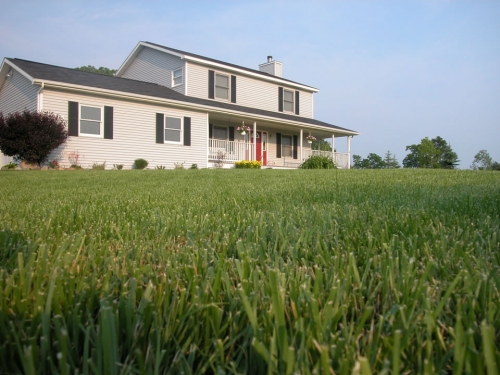To safeguard Michigan’s water resources, check before choosing fertilizers
Following these four simple steps will help you determine what kind of fertilizer you need for your lawn and garden – if any – and how much.
 Are you eager to fertilize your lawn and/or garden? Proper fertilizer selection helps prevent burning plants, saves money and time and avoids polluting local water resources. Be sure to do these four things before purchasing fertilizer.
Are you eager to fertilize your lawn and/or garden? Proper fertilizer selection helps prevent burning plants, saves money and time and avoids polluting local water resources. Be sure to do these four things before purchasing fertilizer.
1. Get your soil tested
Lawn and garden areas may or may not need fertilizer. To determine if fertilizer is necessary or not and in what amount, purchase the Michigan State University (MSU) Extension lawn and garden soil test mailer for $25 from the MSU Extension Bookstore or through a local MSUE office. The test recommendations will tell you what nutrient levels are present in the soil.
It will also indicate the pH (acidity or alkalinity) of your soil. Knowing the acidity or alkalinity is important as it affects the availability of nutrients to plants. With this information, you will be able to determine how much and what type of fertilizer is needed for the plants you want to grow.
2. Plant type(s) to be fertilized
What are you trying to grow? What kind of soil and nutrients are required? For example, rhododendrons and blueberries grow best in acidic soil, so you will need a fertilizer and appropriate soil amendments that create a soil pH with the optimal level of acidity.
3. Calculate the area to be fertilized
Purchase the appropriate amount of fertilizer to prevent having excess that requires storage. The MSU Soil Test website has an online calculator that allows you to conveniently determine the exact area of your lawn or garden, saving you money and protecting the environment from over-fertilization.
4. Carefully read the fertilizer label
The label on every bag of fertilizer provides all the information needed for using that specific fertilizer. By law, fertilizer bags contain three numbers (fertilizer grade) which indicate the percentage of nitrogen, phosphorus and potassium content in that particular fertilizer. The first number indicates the percentage by weight of elemental nitrogen (N). The second number indicates the percent available phosphate (P2O5). The third number indicates the percentage of water-soluble potash (K2O).
For example, 30-3-3 means that the fertilizer is 30 percent nitrogen, 3 percent phosphate, and 3 percent potash. Select phosphorus-free fertilizers, particularly if you are fertilizing near water, to avoid the possibility of it negatively impacting water resources. To learn more about Michigan’s statewide phosphorus restrictions, visit the Be Phosphorus Smart website or read MSU Extension’s article, “Michigan Fertilizer Act helps protect water quality.”
The label on lawn fertilizers will also tell you the area in square feet (ft2) the fertilizer bag will cover. Select a bag that gives you as close to the coverage of the area you wish to fertilize. Don’t over-apply fertilizer or you may burn your lawn.
Finally, be sure to check the label for your brand of fertilizer spreader. If your spreader is not listed, you may want to choose another brand or refer to your spreader directions.
For more information on all things gardening, including proper fertilizer management, visit the Gardening in Michigan website. Another helpful self-guided resource on caring for your yard and garden to avoid impacting the environment is available from the MSU Extension Bookstore is the Home*A*Syst Guide (WQ-51).



 Print
Print Email
Email

